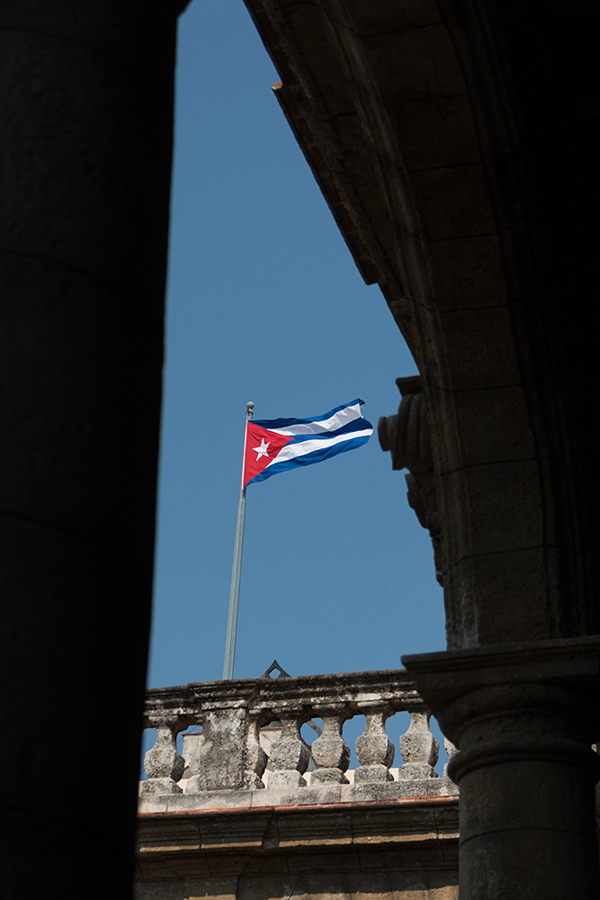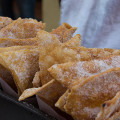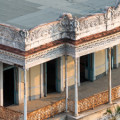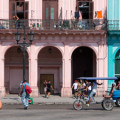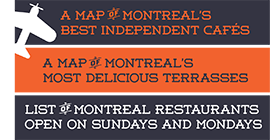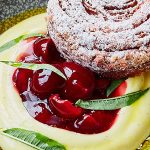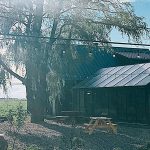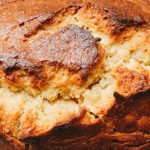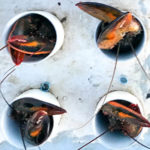Cuba is one of my favourite places on earth and one that I’ve been to often. Sure, I visit for the pristine beaches and to get away from our harsh Canadian winters but I also love the small colonial towns and I am especially fond of its capital, Havana. I must have visited the Caribbean island 8 times by now and have travelled through the entire northern part of it. The first time I visited Havana in 1997 was for a a day trip from Cienfuegos where I was staying. I fell head over heels in love with the immutable city, its colonial buildings, vintage American cars, lovely people and gorgeous light and vowed to return. And return I did, three times since then in fact. On this last trip, I found the city changed since the last time I was there ten years ago. It is more effervescent than ever. There were quite a few renovated buildings scattered around the city and a lot of construction sites busy restoring the city’s glorious architectural gems. There were also a lot more paladares (privately owned restaurants) than before. In fact, there were none the last time I visited but now, food was finally something to be excited about when travelling to Cuba! Flights.com asked me to share more about my experience in Havana so here below is how I spent my first day.
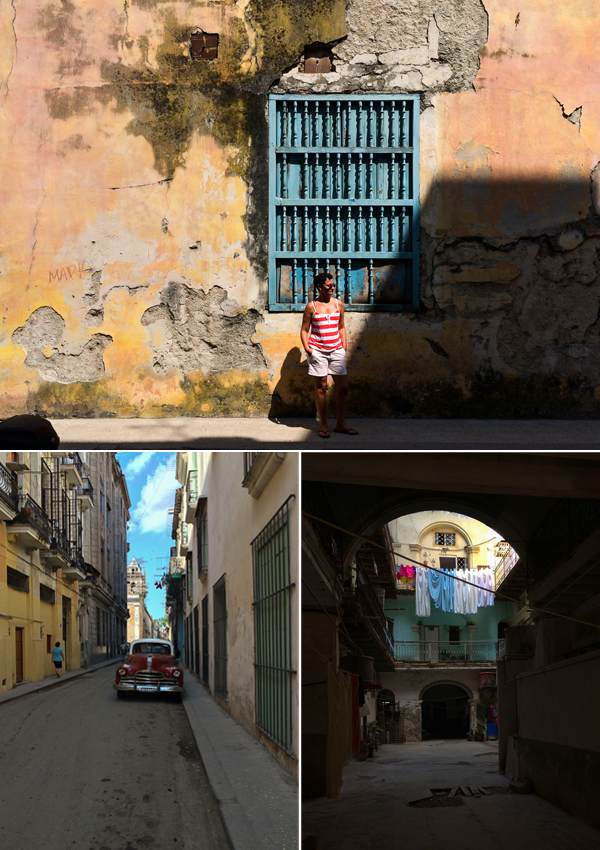
Life in Havana Vieja {photos by mrb404}
BEFORE YOU LEAVE
Get yourself a good guide and read up on the history of this most fascinating city. Make sure it has a good map of the city because you won’t be able to use Google maps in Havana (unless you download a map and use it offline). Internet is very scarce there and you won’t get a connection easily, which is the perfect time to disconnect and travel the old fashioned way. It will seem hard at first but trust me when I say that you won’t miss posting pictures on Instagram or updating your Facebook page. Just enjoy your surroundings and the world will still be there when you emerge.
GETTING AROUND HAVANA
You can easily walk everywhere in Havana. It’s a very safe city and although you’ll be accosted often by Cubans trying to sell you anything from cigars to taxis to paladares (privately owned restaurants), they are easily dissuaded and will let you be with a simple “no, gracias”. If the heat and the city get the best of you or if you are pressed for time, you can grab a taxi, which are normally fairly affordable. Always inquire how much the fare will be before getting in the car. Beware that vintage American cars can cost more than a “regular” sedan–in this case, an old Russian Lada. Coco taxis–basically a scooter fitted with a yellow “egg” shell large enough for a driver and two passengers–are also not cheap but come equipped with meters. Also available are horse drawn carriages, bicitaxis, a tricycle with room for two passengers, or collective taxis, big old American cars recognizable by a taxi sign on that drive basically one route and on which people hop on and hop off. You stop the car, yell out your destination to the driver and he’ll let you know if you should get on or not. They’re generally cheaper than regular “individual” taxis. Note that Old Havana is a car free zone and taxis will deposit you as close as possible to your destination.
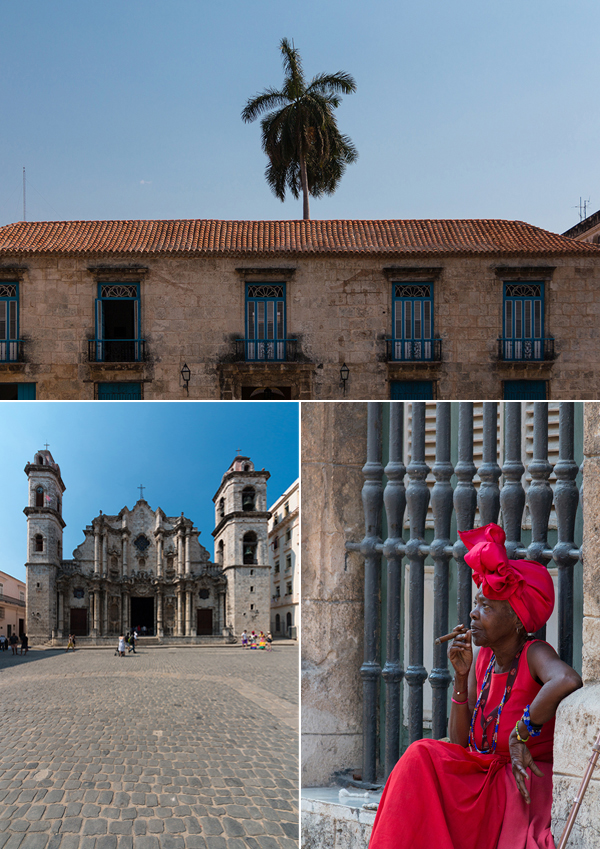
Plaza de la Catedral {photos by mrb404}
WHAT TO DO IN OLD HAVANA
Havana Vieja is a UNESCO World Heritage site and a treasure trove of architectural gems, from baroque to neoclassical to colonial. It is a unique city where the preservation of the original urban layout has been remarkable and an absolute wonderland for anyone interested in architecture or urban planning. The beauty of Havana is only compounded by the fact that it’s a weathered city, beaten up by the elements, the passing of time and lack of material to renovate. However, the chipped painting and crumbling walls only contribute in making it seem even more timeless, unique and ever charming.
Old Havana is built around a series of plazas, five to be exact, around which you will find many outstanding buildings, including countless museums, churches, convents and gorgeous residential buildings all adorned with arcades and elaborate wrought iron gates protecting windows and doorways. Each one of theses plazas is worth a visit and it is fairly easy to walk from one to the other while navigating around the city’s smaller, lesser known streets. It will sometimes feel like stepping off a time machine but that is the surprising beauty of Havana; you might run into a fruit and vegetable vendor displaying his produce right on the sidewalk, or children walking home from school in their pressed uniforms, stray cats and dogs lying down in a patch of shade, spontaneous music playing in the streets or a Cuban dressed in full regalia ready to trap some tourists into taking a photo with him. Just dive into the city and let it transport you.
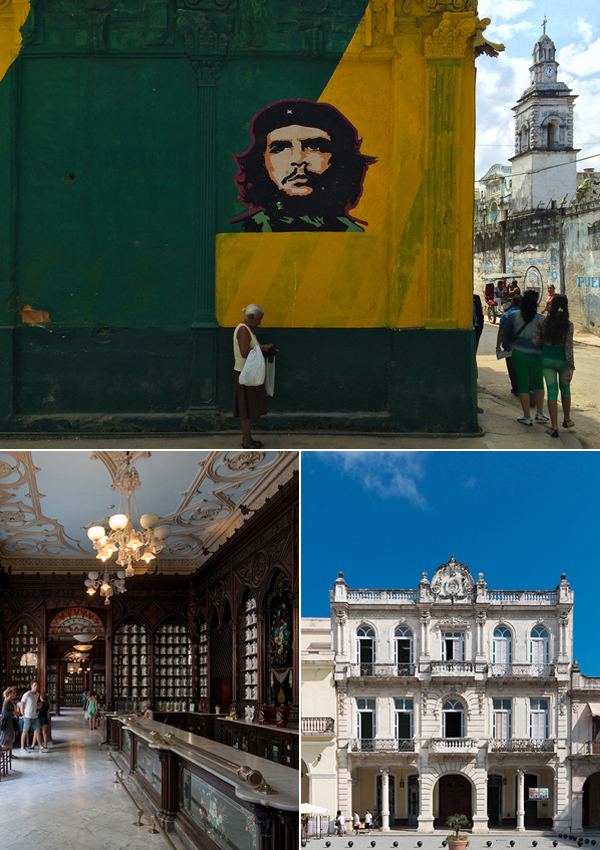
Farmacia Taquechel, Plaza Vieja under the watchful gaze of the Che {photos by mrb404}
Plaza Vieja has been a market place, a bullfighting rink, an execution square and even a parking lot at some point in its history. Today, it’s a beautifully renovated plaza surrounded by colonial buildings of the past four centuries which house hotels, art galleries and cafés. Grab a cup at any one of them–El Escorial being the most popular–do some people watching and admire the central Carrara marble fountain surrounded by a beautiful wrought-iron gate. Not far from the plaza is the Convento de Santa Clara which was unfortunately closed for renovations when I was visiting. I have visited it before and it is lovely. A few streets south of the convent is the Iglesia de La Nuestra Señora de la Merced, a lovely church worth a visit. Beware that you have to have the proper attire to visit all churches in Havana, which translates into no short shorts or skirts and no bare shoulders.
Plaza de la Catedral is where you will find La Catedral de la Virgen María de la Concepción Inmaculada de La Habana (Iglesia Catedral de la Havana or Catedral de San Cristóbal), a beautifully preserved baroque church built in 1727 that looms over the plaza. You can climb up one of its unequal towers for a view of the city. A couple of palacios housing galleries and the Museo del Arte Colonial also call this plaza home, as well as the Seminario de San Marco y San Ambrosio. La Bodeguita del medio–perhaps Havana’s most famous bar and the birthplace of the mojito–is just around the corner from the cathedral if you feel so inclined as to have a drink.
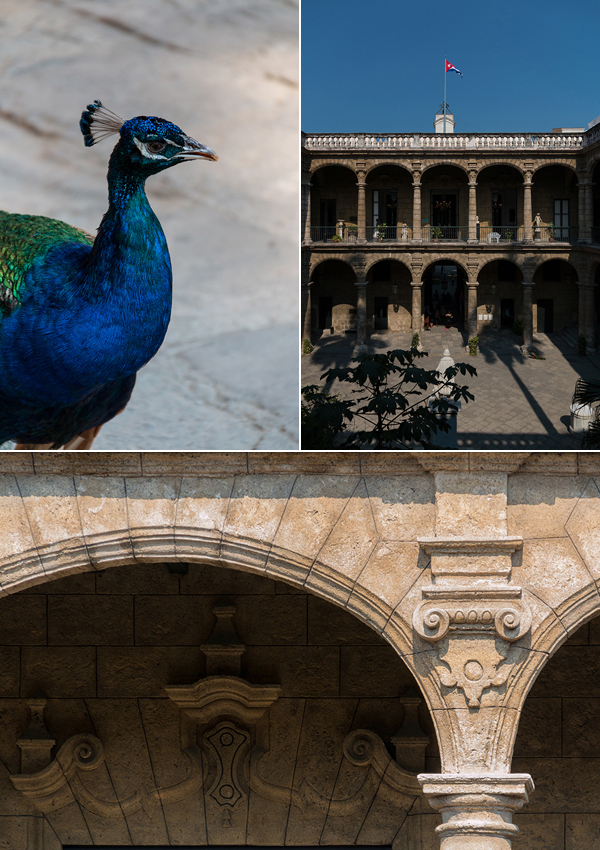
My favourite building in Havana Vieja: Palacio de los Capitanes Generales {photos by mrb404}
Plaza de Las Armas is just around the corner from Plaza de la Catedral and is where you’ll find my favourite building in all of Havana, the Palacio de los Capitanes Generales. The square-shaped palacio is built around a central courtyard home to a couple of free roaming peacocks and houses the Museo de la Ciudad, or the Museum of the City of Havana. It is a gorgeous, sun-drenched buildings with wide, wrap around marble verandas overlooking the courtyard and its two extremely tall palm trees. Walking around the building, one can imagine what it must have been like living here back in Havana’s glory days.
Around Plaza de Las Armas you will also find the Palacio del Segundo Cabo as well as the Museo de Arqueología. The pedestrian street (Calle Tacón) in front of the palacio is lined with book vendors selling volumes of revolutionary literature in all languages. Beyond the vendors lies a lovely park and on the other side you’ll find El Templete, a neo-classical monument symbolizing Havana’s founding. You can also visit the Castillo de la Real Fuerza, Havana’s–and North America’s–oldest fortress. Backtrack a corner or two to Calle Obispo where a slew of “antique” street vendors peddle anything form old movie posters to vintage trinkets like watches, pins and even cutlery. The Museo Nacional de Historia Natural de Cuba is right along Calle Obispo, which you should walk along and admire the different architectural styles lining that most picturesque street. On Calle Obispo is where you will find Farmacia Taquechel, with its impressive collection of old vials and storage vessels still intact.
Plaza de San Francisco is where you will find the Basilica and the Convento de San Francisco de Asís, both worth a visit. Not far from the plaza is the Museo del Ron Havana Club, Cuba’s most famous maker of rum. Guided tours ending in tastings are available and you can purchase rum bottles from their shop.
Plaza del Cristo is Havana’s fifth plaza and it is of lesser importance than the others. It’s also the least touristy one and is worth strolling through.
BEYOND THE PLAZAS
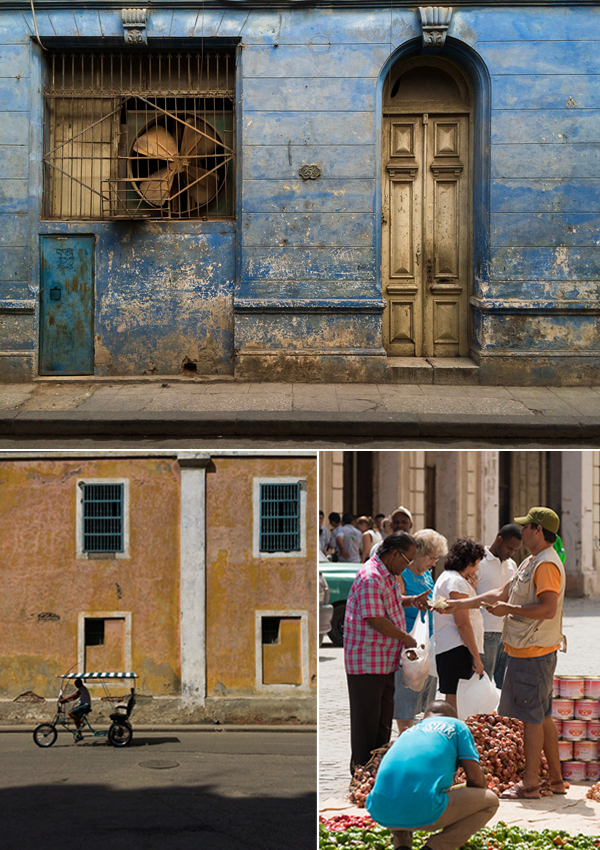
Daily life in Havana Vieja {photos by mrb404}
There are several other things to visit in Old Havana if you have the time. The Bacardi Art Deco building was renovated in the 1990s and although it may need more renovations at this point, it’s a nice architectural site. It’s currently used as an office building but you can get a great view of the city from the top of its tower.
Several museums are worth a visit such as the Museo de la Revolucion and the Museo Nacional de Bellas Artes. Castillo del Morro, Fortaleza de San Carlos de la Cabaña and Castillo San Salvador de la Punta are some of the fortresses guarding Havana’s bay that you can go on a tour of.
WHERE TO EAT IN OLD HAVANA
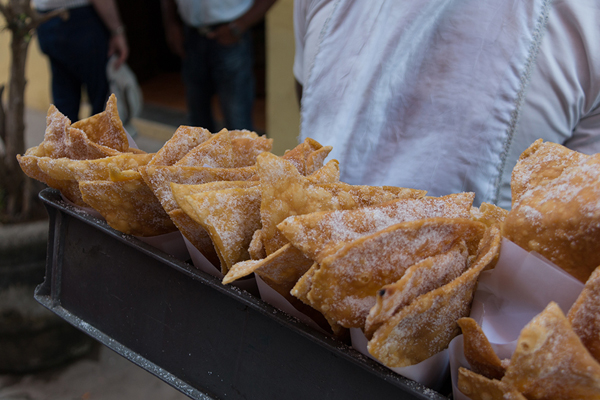
Street food vendor selling chiviricos (fried dough) in Havana Vieja {photo by mrb404}
Doña Eutimia is located on a small side street off of Plaza de la Catedral. Reservations are a must at this bustling restaurant. I actually reserved by sending them a message via their Facebook page. The food here is Cuban. Must tries include the croquetas de Leticia, fish croquettes breaded and fried; the tostones relienos, hollowed-out plantain pieces with different fillings; the ropa vieja, a typical Cuban shredded beef dish (here made with lamb) that I actually ordered everywhere because it’s one of my favourites; and finally, the picadillo a la habanera, ground beef cooked with olives and raisins. Side dishes include white rice, black beans, fried plantains and a fresh salad. The lemonade was one of the best I’ve ever had!
Café Escorial is one of the cafés on Plaza Vieja. The majority of cafés in Havana have an espresso machine so you can order any espresso-based drink. The milk used is a UHT, shelf stable kind so it won’t taste like your sustainable, fair trade, third wave coffee at home but it will be nice enough. We had bad service at Café Escorial but the setting was charming and it made up for it.
Café O’Reilly is a hip café on O’Reilly street, just around the corner from Plaza de la Catedral, perfect for a drink or a snack, especially if you manage to score a seat on the second floor balcony for some people watching.
La Bodeguita del Medio is one of Havana’s most popular and touristy spots. It claims to be the birthplace of Cuba’s most famous cocktail: the mojito. It’s also where a slew of famous people like Hemingway and Neruda spent a great majority of their time. The walls are covered floor to ceiling by patrons signatures, including this famous quote from Hemingway: “My mojito in La Bodeguita, my daiquiri in El Floridita”. The food is typical Cuban and includes rice and beans, plantains, chicken and pork. And of course, you absolutely have to have a mojito there.
If you need to rest at any point, I would recommend getting a coffee or a drink in the lobby of any of the grand hotels around Old Havana. They’ll probably have air conditioning too, which will be a nice respite from the brutal heat outside.
OUR MAN IN HAVANA
I couldn’t have planned my trip to Cuba without the help of Raúl Rodríguez of Suite Cuba. Raúl was instrumental in providing long distance transport (from Trinidad to Havana), airport transfers, restaurant reservations when I couldn’t make them on my own and most importantly, outstanding accommodations. We stayed in a 10th floor apartment with breathtaking 360-degree views in the heart of Vedado, a beautiful residential neighbourhood. Cuba is unlike other countries and it can still be difficult to book everything via the internet. Raúl is your man if you’re in need of anything and he can help you customize your trip in order to make the most it stress free. I really cannot recommend him highly enough.
Although El Capitolio and Paseo del Prado are officially part of Old Havana, I’ll be talking about them in my next blog post, along with Havana Centro where I found my favourite restaurant! You can also read about my third article on Vedado, the neighbourhood where I stayed.
I am convinced that Havana must be one of the most photogenic places on earth. I can only fir so many photos in one blog post. To see more photos of my Cuban trip, click here.
Check out more food adventures to take on Flights.com


